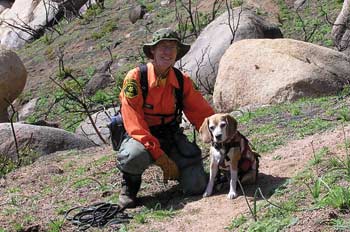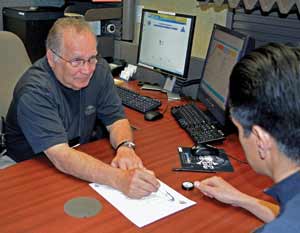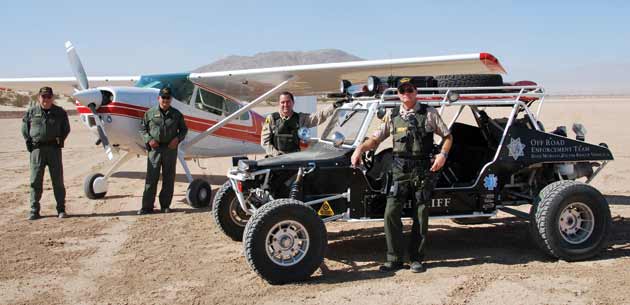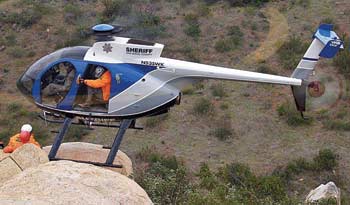
reserves_3
As a reserve officer you’ve likely worked with canine officers and are familiar with their techniques. The most valuable point to remember when around the dogs while they’re at work is to stand still, because we know the dog will bite the first person they see running! But what happens when your subject is missing or is in some type of natural disaster? A specialized Search and Rescue (SAR) canine is needed and is a whole different type of animal.
Several of the larger police agencies in California have reserve divisions within their organizations that cover the law enforcement duties and search and rescue details. The San Diego Sheriff’s Department Search and Rescue unit has been in existence since 1963.
The unit is comprised of reserve officers, rescue volunteers and some well-trained canines. The San Diego Sheriff’s Department SAR Canine Teams are available 24 hours a day and can be dispatched anywhere in the US. They currently have about a dozen members and 15 canines. The Orange County Sheriff’s Department also has a SAR division, including a K-9 Operation/Bloodhound Squad.
One of the rescue volunteers in the San Diego Sheriff’s Department is Pam Medhurst. Pam is a unit leader and travels all over the western states providing instruction to law enforcement agencies on tracking. According to Pam, there are several types of training for canines, but they usually fall into two areas: trailing or area.
Unlike police K-9 units, search and rescue dogs can be many different
breeds, from beagles to classic hound dogs. The role may dictate the best type of pooch.
Makes Scents …
Trailing dogs are trained to follow the scent of a missing person. These dogs require a properly preserved scent, usually work on long leashes and can work trails several days old. Trailing dogs will work on and off lead, and may venture off the actual path a subject took as they sort through all other human scents in the area.
Area search dogs are trained to find any human scent in an area. These dogs usually work off-leash and can be used in urban settings, wilderness or very large areas. Area dogs are usually non-scent discriminating and can locate a scent from any human as opposed to a specific person. It’s estimated a single-dog team can be as effective as 20 or 30 trained human searchers.
How is it these dogs can find a person who left the area a couple of days ago, and might be miles away? Both types of search dogs are trained to detect human scent. One part of this scent includes skin rafts (scent-carrying skin cells that drop off living humans at a rate of about 40,000 cells per minute), evaporated perspiration, respiratory gasses or decomposition gasses released by bacterial action on human skin or tissues.
There are also specialized dogs that search for the remains of deceased victims. The Human Remains Detection (HRD) dogs may work on or off lead. Area dogs and trailing dogs are often cross-trained as cadaver dogs, as they can locate entire bodies, decomposed bodies or body fragments. SAR dogs were used at the World Trade Center in New York on Sept. 11, 2001.
In the aftermath of the Joplin, MO tornado, search dogs were used to
help find survivors and the remains of victims. It was tough going for both dogs and handlers.
Massive Training
The training process for the handler and K-9 is far more extensive than our reserve officer academy. For the dog, the training starts early, at 8 to 10 weeks of age. It covers obedience training and socialization skills, and handling bonding is especially important for air-scenting dogs. The puppies are trained two to five times a day, for up to 60 minutes in each segment. Scent training demands three to seven times per week, for up to 30 minutes per session. As the dog gets older and his abilities improve, the training decreases on both.
To keep current, search dogs need once-a-week training sessions focusing on scent decimation. The dog must also be trained in body language when he/she finds the subject. The dog may return to the handler and sit, perform a jump-up, bark, grab a decoy or other notice move.
An alert by an air-scenting dog can be distinct, and involve the handler being able to read the dog’s behavior. Alerts are usually a change in the dog’s behavior, and can be pointing, circling or some other maneuver. A seasoned handler will recognize these alerts and monitor the attention of the dog.
The training techniques for the handlers and their dogs vary by area location and what function the dog is performing. If you are interested in search and rescue you should contact your local police agency and see what they have to offer. Search and rescue is fulfilling volunteer work, and you get to take your partner home with you every night!
By Doug Sherman
>> Click Here << To Order Your Copy Of The American COP May 2013 Issue Today!

















